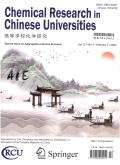高速剪切法制备负载5-氟尿嘧啶的聚乳酸-共乙二醇-共甲氧基聚乙二醇纳米颗粒
IF 3
4区 化学
Q2 CHEMISTRY, MULTIDISCIPLINARY
引用次数: 3
摘要
以聚乳酸-共乙二醇-共甲氧基聚乙二醇(PLGA-mPEG)为负载材料,采用高速剪切双乳法制备了5-氟尿嘧啶(5-FU)负载纳米颗粒。制备的NPs具有负zeta电位,其负载效率约为15%(质量分数)。体外释放结果表明,5-FU在NPs中的释放行为与第2天起的零水平释放行为一致。本文章由计算机程序翻译,如有差异,请以英文原文为准。
Preparation of 5-Fluorouracil Loaded Polylactide-co-glycolide-co-methoxy Poly(ethylene glycol) (PLGA-mPEG) Nanoparticles via High Speed Shearing
5-Fluorouracil(5-FU) loaded nanoparticles(NPs) were prepared by a high speed shearing double emulsion method with polylactide-co-glycolide-co-methoxy poly(ethylene glycol)(PLGA-mPEG) as loading material. The prepared NPs possess a negative zeta potential and their loading efficiency is about 15%(mass fraction). The result of in vitro release shows that the release behavior of 5-FU from NPs is coincident with Zero-level release from the second day.
求助全文
通过发布文献求助,成功后即可免费获取论文全文。
去求助
来源期刊
CiteScore
5.30
自引率
6.50%
发文量
152
审稿时长
3.0 months
期刊介绍:
The journal publishes research articles, letters/communications and reviews written by faculty members, researchers and postgraduates in universities, colleges and research institutes all over China and overseas. It reports the latest and most creative results of important fundamental research in all aspects of chemistry and of developments with significant consequences across subdisciplines.
Main research areas include (but are not limited to):
Organic chemistry (synthesis, characterization, and application);
Inorganic chemistry (bio-inorganic chemistry, inorganic material chemistry);
Analytical chemistry (especially chemometrics and the application of instrumental analysis and spectroscopy);
Physical chemistry (mechanisms, catalysis, thermodynamics and dynamics);
Polymer chemistry and polymer physics (mechanisms, material, catalysis, thermodynamics and dynamics);
Quantum chemistry (quantum mechanical theory, quantum partition function, quantum statistical mechanics);
Biochemistry;
Biochemical engineering;
Medicinal chemistry;
Nanoscience (nanochemistry, nanomaterials).

 求助内容:
求助内容: 应助结果提醒方式:
应助结果提醒方式:


